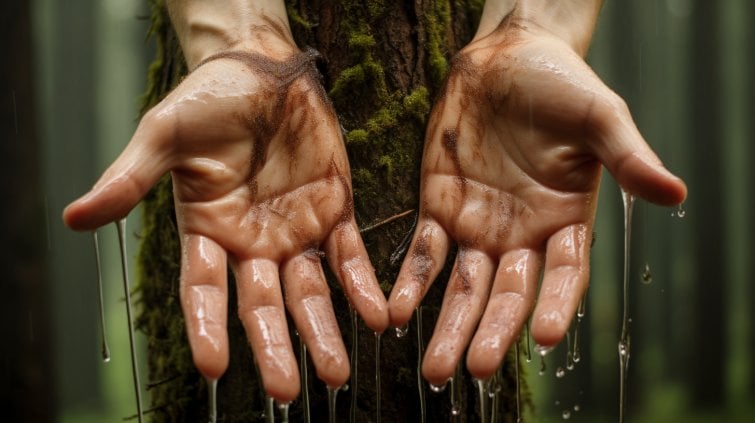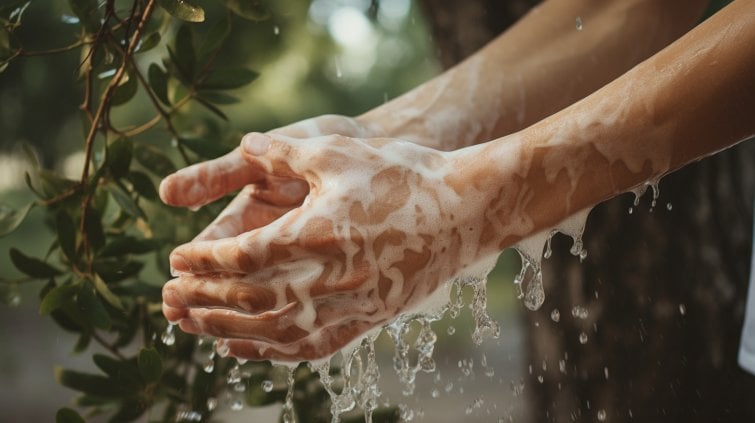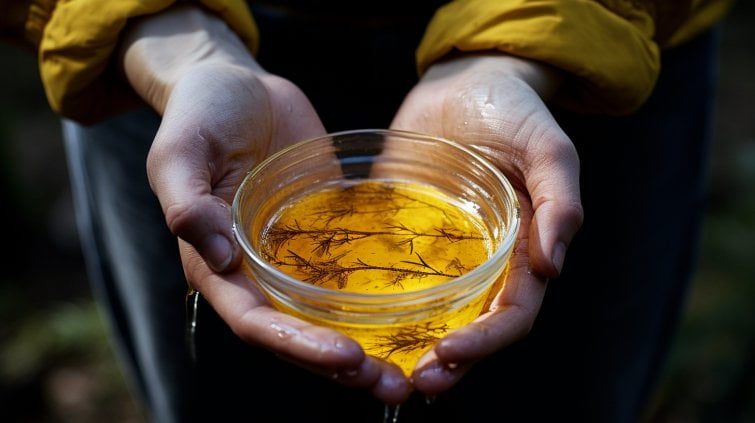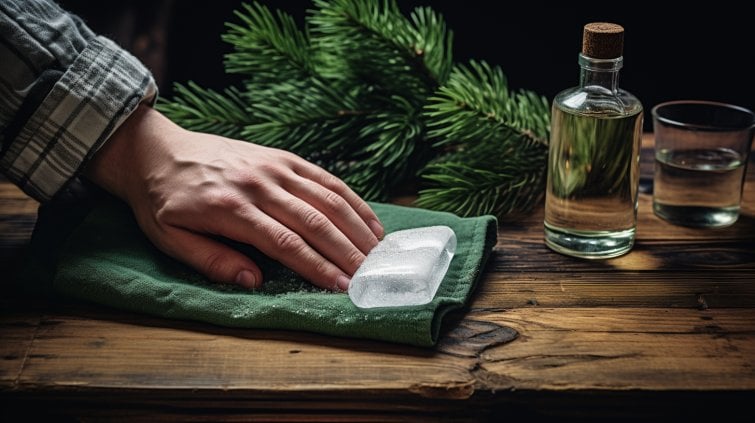How To Remove Sap From Hands: Easy Ways to Get Tree Sap Off Your Hands
Hello there! I’m quite well-versed in dealing with the problems that stubborn tree sap can cause. This sticky substance can be a real nuisance, especially when it adheres to your skin, apparel, or equipment. However, you need not worry! I’ve come across a range of reliable DIY and commercial solutions for sap removal from hands. I’m excited to impart these suggestions to you, to help you manage this challenging predicament.
Stick with me, and you’ll learn how to remove it quickly and efficiently, even when you’re out in the wilderness.
Ready for some hands-on advice? Let’s dive in.
Key Takeaways
- Regular hand washing is not effective in getting rid of sap.
- Vegetable oil, butter, peanut butter, and alcohol-based solutions can effectively dislodge sap from hands.
- Baking soda and dish soap form a powerful scrub to remove it.
- There are commercial products designed specifically to remove it from hands.
Understanding the Stickiness: What Makes Tree Sap So Hard to Remove?

Sticky situation? Discover quick ways to remove sap from your hands before you pick up that electric pruning saw!
Let’s start by discussing why it is so sticky and difficult to remove.
If you’ve ever tried washing it off, you’ve probably found that regular hand washing doesn’t seem to do the trick.
We’ll also discuss why you shouldn’t leave it on your skin for too long.
A Look into the Sticky Nature of Tree Resin
I’m now going to delve into the mystery behind the stubborn stickiness of sap, which is notoriously hard to remove from our hands. The sticky nature of tree resin is due to its unique chemical composition. This sticky sap is a defense mechanism of the tree, designed to seal wounds and deter pests.
Its stickiness is an inconvenience to us but a lifeline for the tree. The difficulty of removing resin from hands is a testament to its effectiveness. Tree resin’s resilience is a marvel of nature. Its stubborn nature is a reminder of the tree’s fight for survival.
Understanding the why behind the stickiness allows us to better tackle how to get rid of it. With knowledge comes mastery.
Why Conventional Hand Washing Fails to Completely Remove Sap
Despite scrubbing vigorously, you’ll find that conventional hand washing often fails to completely remove it, mainly due to its chemical composition’s unique, sticky nature. You may wash your hands repeatedly, but some residue will likely remain.
Why is this? The sap on your hands isn’t just a simple substance; it’s a complex mixture of organic compounds that stick to your skin and resist water. The oils in it repel water, making it hard for the soap and water of conventional hand washing to truly remove it.
You’ll need more than just soap and water to truly get the resin from your hands. Understanding these properties will help you master the art of sap removal.
Possible Risks of Leaving Sap on Your Skin
While someone might think it’s harmless to leave it on their skin, it’s crucial to know that there are possible risks associated with it, and understanding why it’s so hard to remove can give you a better idea of these risks.
Once it comes in contact with your skin, this sticky substance adheres stubbornly due to its unique chemical composition.
- It can cause allergic reactions in sensitive areas
- Prolonged exposure can lead to flaky skin
- The stickiness can attract harmful bacteria
- It may stain or discolor your skin
These are the potential pitfalls of leaving it on your skin. So, it’s not just about the inconvenience of a sticky hand; the risks are real and can affect your skin’s health.
Understanding this can encourage better removal practices.
Domestic Solutions: Natural Methods On How to Remove Sap from Hands

Let’s now focus on some household remedies that can help us out.
I’ve found that common items like vegetable oil, butter, and alcohol-based solutions like hand sanitizer can do wonders.
And don’t underestimate the power of baking soda combined with dish soap; it’s truly magical against stubborn sap.
Dislodging Sap with the Help of Vegetable Oil and Butter
I’ve found that one can effectively get rid of it from their hands using everyday items like oil and butter. This method of dislodging sap with the help of oil and butter is a natural and affordable solution.
- You start by coating the affected areas of your hands with oil.
- Then, gently work the oil into the sap, which should start to break down.
You can also smear a good amount of peanut butter onto it, as the oils in the peanut butter will work similarly to the oil.
- Lastly, wash your hands with warm water and soap.
In these simple steps, you can remove resin from your hands and restore their clean, sap-free state. This is an effective way to get it off hands using household items.
Using Alcohol-Based Solutions, Such as Hand Sanitizer
In addition to using vegetable oil and butter, an alcohol-based solution like hand sanitizer can also be useful in removing resin from your hands. The key component in a sanitizer that works to get the sap off hands is alcohol. Alcohol-based solutions are great at breaking down and dissolving many substances, including sap.
To use this method:
- Simply apply a generous amount of sanitizer to the affected area of your hands.
- Rub the sanitizer into it until it starts to loosen. Once it dissolves, you can rinse your hands with warm water.
- Remember that it may take a few applications to completely remove it.
The Magic of Baking Soda and Dish Washing Soap on Sap
Often, I turn to baking soda and dish soap as a reliable yet natural method for removing stubborn sap from my hands, and it’s a solution that’s typically readily available in most households. This combination creates a potent scrub, which works wonders to get that sticky gummy thing off your hands.
When using this method, consider the following steps:
- Combine equal parts of baking soda and dishwashing soap to form a paste.
- Apply this mixture to your sap-covered hands.
- With vigor, scrub your hands together.
- Rinse thoroughly with warm water and soap.
The magic of baking soda and dishwashing soap lies in their combined abrasive and degreasing properties. They not only remove the sap but also leave your hands feeling clean and soft.
Store-Bought Helpers: Special Products Designed to Get Sap Off Your Hands

Now, let’s turn our attention to some store-bought options specifically designed to remove sap from your hands.
There are various commercial products out there, but we’ll need to discuss how to care for your skin after using these chemical-based solutions.
We’ll also look at ratings and reviews to help you choose the best removal product.
Exploring Commercially Available Sap Removing Products
Let’s dive into my exploration of commercially available sap-removing products that are specifically designed to get this sticky substance off your hands. They’re godsend products that make the process of removal a breeze.
To evoke a sense of excitement and anticipation, here are a few highlights of my journey:
- Discovering that some products not only remove pine sap but also cleanse and moisturize your hands.
- Finding out that certain items are biodegradable, caring for both your hands and our planet.
- The joy of realizing that several products also work to get it off your hands from other species.
- The relief of knowing that these commercially available sap-removing products are easily accessible and affordable.
Exploring commercially available sap-removing products has been enlightening, making the removal less of a chore and more of a satisfying accomplishment.
Skin Care After Using Chemical-Based Sap Removers
I’ve noticed that proper skin care is crucial after using chemical-based sap removers to keep my hands healthy and hydrated. The affected area, often left dry and irritated, needs proper attention.
First, I wash the sap and chemicals from my hands with soap. This is vital as it removes any residue that may continue to irritate my skin. Using a gentle soap helps to avoid further drying out my skin.
Then, I rinse my hands with warm water. This not only washes away the soap but also opens my pores, allowing my skin to absorb any moisturizer I apply.
I’ve found this skincare after using chemical-based removers to be the best way to restore my skin’s natural moisture and health.
Ratings and Reviews: Top-Rated Sap Removal Products
Among the countless products on the market, I’ve found that some are more effective than others at getting rid of it from hands. These top-rated removal products have stellar ratings and reviews, proving their efficacy in getting it off the skin.
- Goop Hand Cleaner: This non-toxic, biodegradable soap isn’t only effective at removing stubborn sap but also safe for your skin.
- Sap Remover Wipes: These wipes can instantly remove sap, leaving your hands clean and moisturized.
- Turpentine: Though harsher, it’s an old-school method that works.
- Dish Soap: A simple soap and water solution can sometimes do the trick.
Quick Fixes: Removing Sap from Skin and Hair When You’re Out and About

You don’t need to panic when you’re outside and suddenly find sap sticking to your skin or hair. There are handy solutions like using wet wipes or sanitizers for immediate relief.
If you’re in a more rustic setting, you can even use pine needles to remove it.
I’ll also share some tips on how to prevent this sticky situation altogether.
Handy Solutions: Using Wet Wipes and Sanitizers for Immediate Relief
Even though you’re out and about, there’s no need to panic if you get it on your skin or hair because wet wipes and sanitizers can provide an immediate solution. These handy solutions, using wet wipes and sanitizers for immediate relief, can help you get it off your hands quickly and efficiently. Here’s a quick guide:
- Make sure you always carry wet wipes or sanitizers. They’re not just for hygiene but also for unexpected sap encounters!
- Use a wet wipe to gently rub it off your hands and skin.
- If the sap is stubborn, apply a generous amount of sanitizer. Its alcohol content helps dissolve it.
- Finally, rinse your hands or hair under warm water if available.
Off the Beaten Path: Using Pine Needles to Shed Pine Sap
I’m in the heart of nature, and believe it or not, I’ve found that using pine needles is an effective way to get rid of sap from my skin and hair.
When I get the sap on my hands and clothing, I simply reach for a clump of pine needles. By rubbing the needles against the sticky areas, the sap starts to come off.
This method is particularly useful when I have no immediate access to water or cleaning products. It’s amazing how something as simple as pine needles can effectively get resin off skin and hair.
Prevention Tips: How to Avoid Getting Sap on Your Hands
Let’s dive into some prevention tips now, starting with how to avoid getting it on your hands in the first place. The key to this lies in the principle of prevention rather than cure.
Here’s a quick list of prevention tips:
- Always wear gloves when handling a Christmas tree, pine cones, or sap-producing plants.
- Apply a barrier cream to your hands before touching anything that might cause sap to stick.
- Carry wet wipes; they can quickly remove sap when you’re out and about.
- Avoid touching your hair after handling sap-laden objects, as getting out can be a nightmare.
Don’t Forget Your Tools: Getting Sap Off Equipment and Clothing

Now that we’ve covered removing sap from our skin and hair let’s not forget about our tools and clothing.
It’s equally important to know how to remove fabric stains and keep our garden tools sap-free and functional. This knowledge ensures the longevity of our outdoor gear amidst those unavoidable sap encounters.
Removing Sap Stains from Clothes and Fabrics
Before we dive into the details, it’s important to note that if you’re dealing with sap on your clothes or tools, time is of the essence for successful removal. Sap is akin to gum, so the same urgency applies.
Here’s how I tackle removing stains from clothes and fabrics:
- Use a piece of ice to harden the sap and make it easier to remove.
- Scrap off the hardened sap with a blunt knife.
- Dab a clean cloth soaked in rubbing alcohol on the stain.
- Rinse with warm water and repeat if necessary.
Do not despair if the sap has already dried. Rubbing alcohol can help dissolve the sap, like when removing gum. With patience and persistence, your clothes or tools can be sap-free again.
Keeping Your Garden Tools Sap-Free and Functional
I’ve covered how to get sticky sap off your hands and clothes, but your garden tools also need attention to stay sap-free and functional.
Just like sap on the hands, sap on tools can be stubborn. My tip for removing this sap is to use an oil-based product. Apply it on the sap-covered area, leave it for a few minutes, then wipe it off.
If you want to prevent getting it on your tools in the first place, consider spraying them with a silicone or Teflon lubricant before use. This forms a barrier that stops the sap from sticking.
Maintenance is key in keeping your garden tools sap-free and functional. Remember, a clean tool is a happy tool!
Ensuring the Longevity of Your Outdoor Gear Amidst Sap Encounters
As we venture into the outdoors, we must discuss not only how to keep ourselves sap-free but our gear and clothing as well. Ensuring the longevity of your outdoor gear amidst sap encounters can be a bit of a challenge, but it’s not impossible.
- Learn how to get rid of sap on my hands and apply the same principles to your gear.
- Find the best way to remove it from your hands, as the same method can be used on fabric and metal.
- Always clean your gear immediately after use to prevent sap from hardening.
- Invest in quality cleansers specifically designed for removal.
In this way, you’ll extend the life of your outdoor gear and keep it sap-free.
Frequently Asked Questions
What Types of Trees Produce the Most Sap?
In my experience, maple, pine, and birch trees produce the most sap. They’re often tapped for their sap, which can then be processed into products like syrup, resin, and even certain medicines.
Is Tree Sap Harmful if Ingested or if It Comes Into Contact With the Eyes?
Ingesting tree sap isn’t usually harmful but depends on the tree species. However, getting it in your eyes can cause irritation. It’s best to avoid contact and promptly wash if it occurs.
How Long Does It Typically Take for Sap to Harden on the Skin?
Depending on the type of sap, it can harden on the skin within a few minutes to a couple of hours. Promptly removing it is important to avoid discomfort or potential skin irritation.
Can Tree Sap Cause Allergic Reactions on the Skin?
Tree sap can cause allergic reactions on the skin. It’s not common, but I’ve seen cases of dermatitis caused by it. Symptoms include redness, itching, and sometimes blistering. Always wash it off immediately.
Are There Any Preventative Measures to Avoid Getting Sap on Your Hands When Handling Trees?
There are preventative measures. I always recommend wearing gloves when handling trees. It’s also wise to wear long sleeves to prevent sap from sticking to your skin. It’s about planning and protection.
Conclusion
So there you have it, folks! Getting tree sap off your hands isn’t as daunting as it seems. It’s doable whether you’re using natural home remedies, store-bought solutions, or quick fixes out in the field.
And don’t forget about your tools and clothes! You can say goodbye to that sticky mess with a little patience and the right methods.
So go ahead and enjoy your outdoor activities without worrying about sap. You’ve got this covered!







